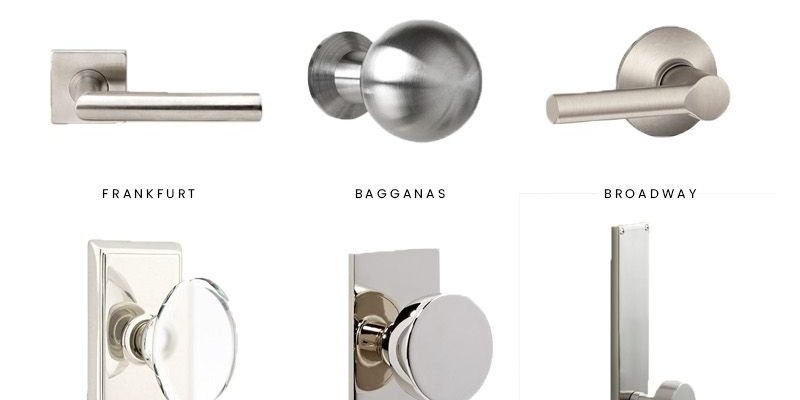
Think of hardware as the accessories for your door. Just like you wouldn’t wear bracelets that are too tight or shoes that pinch your feet, using the right hardware for your door’s thickness is crucial for functionality and aesthetics. In this guide, we’ll explore how to navigate the selection process, ensuring your door hardware not only fits but also enhances your space.
Understanding Door Thickness Standards
Before diving into hardware selection, it’s essential to understand the common door thicknesses. Most interior doors are either 1 3/8 inches or 1 3/4 inches thick. However, you may encounter doors that deviate from these standards, especially in custom builds or older homes.
For example, if you’ve got a hefty 2-inch thick door, standard hardware won’t do the trick. You might end up with hardware that won’t fit properly, causing issues like improper closure or even door damage. Always measure your door thickness accurately to ensure you have the right dimensions before you start shopping for hardware.
Measuring Your Door
Accurate measurements are key. To measure your door thickness:
- Use a tape measure: Place it against the edge of the door where it meets the frame.
- Record the width: Make sure you measure from one edge to the other, avoiding slight warps that might skew your reading.
Once you have your measurement, you can confidently look for hardware designed for that specific thickness. Here’s the thing: many manufacturers label their products based on door thickness, making it easier to find compatible options.
Types of Door Hardware
Now that you have a clear understanding of your door’s thickness, let’s delve into the types of hardware you’ll need. Hardware can range from basic knobs and handles to more complex systems like deadbolts or electronic locks. Each type has its own compatibility requirements based on door thickness.
For instance, a standard doorknob often requires a hole that fits a 2 1/8-inch diameter. If your door is thicker than normal, you might need to purchase a special lockset that accommodates that thickness. Here’s a quick breakdown of the common hardware types:
- Knobs and Handles: Most common for standard doors.
- Deadbolts: Provide additional security, requiring specific thickness adjustments.
- Hinges: Ensure your door swings smoothly; thicker doors may need heavy-duty hinges.
- Electronic Locks: Require compatible mounting options for unique thicknesses.
Choosing the right type is essential not only for functionality but also for the overall look of your door.
Choosing the Right Hardware for Unique Thicknesses
When you’re dealing with unique door thicknesses, compatibility is crucial. You might be wondering why some hardware options are labeled for specific thicknesses. This is because a standard lockset designed for a 1 3/8-inch door won’t align correctly on a 2-inch door, leading to potential security issues.
So, when selecting hardware, consider these points:
- Consult the manufacturer’s specifications: Often, manufacturers provide detailed guidelines for which thicknesses are compatible with their products.
- Ask for recommendations: If you’re unsure, your local hardware store can offer valuable advice especially if they carry specialty items.
- Look for adjustable options: Some hardware is designed to accommodate a range of thicknesses, which can be a lifesaver for unique doors.
With the right approach, you can find hardware that fits both snugly and stylishly, ensuring smooth operation.
Adjusting Hardware for Unique Thicknesses
Sometimes, even with the right hardware, you may need to make some adjustments for a perfect fit. Don’t fret—many adjustments are straightforward and can be done with basic tools.
For instance, if your door is slightly thicker than standard, you can often shim the hardware using thin pieces of wood or metal. This fills the gap, allowing your lock or knob to sit properly. Here’s how to do it:
1. Determine the gap: Measure the space between the hardware and the door surface.
2. Cut your shim: Use a material that’s sturdy yet thin enough to fit the gap.
3. Install the shim: Place it behind the hardware before tightening the screws.
This simple tip can save you from returning equipment or hunting for costly custom parts.
Choosing Quality Hardware
Investing in quality hardware can make all the difference, especially for doors with unique thicknesses. While it might be tempting to go for the cheapest option, remember that lower quality often leads to issues down the line, like misalignment or security vulnerabilities.
Look for brands known for durability and design. For example, brands like Schlage and Kwikset offer a range of products tailored for different thicknesses and provide reliable security and aesthetic choices.
It’s also worth considering materials. Solid brass and stainless steel are great for longevity, while plastic or composite materials might not hold up as well for thicker, heavier doors.
Installation Tips for Unique Thicknesses
Once you’ve selected your hardware, it’s time for installation. If you’re new to DIY projects, hardware installation can feel daunting, but it doesn’t have to be. Here are a few tips to help you along the way:
- Read the instructions: Every piece of hardware comes with a manual—don’t skip it!
- Use the right tools: Gather all the necessary tools beforehand, like a drill, screwdriver, and level.
- Consider professional help: If you’re unsure or if the door is especially heavy, hiring a pro might be the best bet.
A well-installed piece of hardware can elevate the look and functionality of your door while ensuring it operates smoothly.
Final Thoughts on Selecting Hardware for Unique Door Thicknesses
Choosing the right hardware for interior doors with unique thicknesses may seem tricky, but it’s really all about understanding your door and matching it with the right pieces. With the right measurements, materials, and attention to detail, you can achieve a seamless look and functionality.
Remember, don’t rush the process—take your time to choose quality hardware that fits well. This isn’t just about aesthetics; it’s about making sure your door stands the test of time. So go ahead, make your selections thoughtfully, and enjoy the satisfaction of a job well done!
